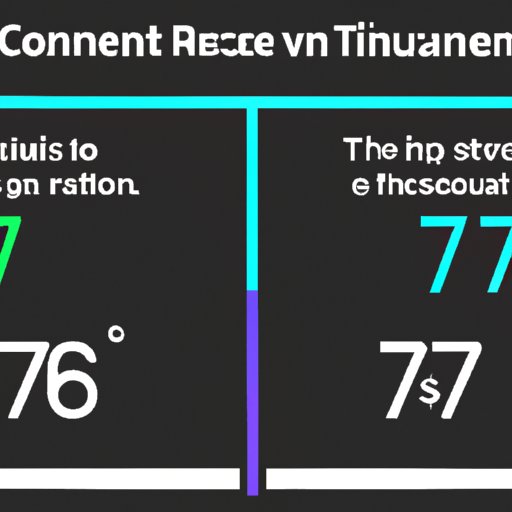Introduction
The Rule of 72 is a popular financial tool that can be used to calculate how long it will take to double an investment, or what the future value of the investment will be. The rule states that if you divide 72 by the annual rate of return on an investment, you will get the number of years it will take for the investment to double. For example, if you invest in an asset with a 6% rate of return, the Rule of 72 tells us that the investment will double in 12 years (72 divided by 6).
In addition to helping investors understand how their investments will grow over time, the Rule of 72 also provides insight into the power of compound interest. Compound interest is the process of earning interest on both the original investment and any accumulated interest from previous periods. Compound interest is one of the most powerful concepts in finance, and understanding how it works is essential to achieving financial goals.

Exploring the Rule of 72: A Guide to Compound Interest in Finance
The Rule of 72 is based on the power of compound interest, which allows investors to earn returns on their original investment as well as on any accumulated interest from previous periods. Compounding occurs when an investor reinvests the interest they have earned on an investment, allowing them to earn even more interest on their original principal. By reinvesting their earnings, investors can increase their wealth over time.
How Does the Rule of 72 Work?
The Rule of 72 is a simple calculation that can be used to approximate the time it takes for an investment to double. To calculate the time it will take to double an investment using the Rule of 72, simply divide 72 by the annual rate of return on the investment. For example, if an investor has an investment with an 8% annual rate of return, it would take 9 years (72/8) for the investment to double.
Examples of Calculating Compound Interest with the Rule of 72
Let’s look at some examples of how the Rule of 72 can be used to calculate compound interest. Suppose an investor has $10,000 invested at a 4% annual rate of return. Using the Rule of 72, we can calculate that it would take 18 years (72/4) for the investment to double in value. After 18 years, the investor’s $10,000 investment would be worth $20,000.
Now let’s look at a different example. Suppose an investor has $100,000 invested at a 10% annual rate of return. Using the Rule of 72, we can calculate that it would take 7.2 years (72/10) for the investment to double in value. After 7.2 years, the investor’s $100,000 investment would be worth $200,000.
Using the Rule of 72 to Help You Achieve Financial Goals
The Rule of 72 is a useful tool for helping investors achieve their financial goals. By understanding how the Rule of 72 works, investors can set realistic goals and plan for the future. The Rule of 72 can also help investors understand the power of compound interest, which can be used to maximize returns and grow wealth over time.
Setting Financial Goals and Using the Rule of 72 to Reach Them
The first step in using the Rule of 72 to help you achieve your financial goals is to set realistic goals. Consider your current financial situation and decide what you want to accomplish in the next few years. Once you have set your goals, you can use the Rule of 72 to determine how much time it will take for your investments to reach those goals. For example, if you are saving for retirement and want to double your investments in 10 years, you can use the Rule of 72 to calculate the rate of return you need to achieve your goal (72/10 = 7.2%).
Understanding Risk and Return when Investing with the Rule of 72
It is important to remember that higher rates of return come with higher levels of risk. When investing with the Rule of 72, it is important to understand the level of risk associated with the investment and make sure it is appropriate for your financial goals and risk tolerance. As Warren Buffett famously said, “Risk comes from not knowing what you’re doing.”

How to Use the Rule of 72 to Increase Your Wealth
The Rule of 72 can be used to increase wealth over time by taking advantage of compound interest and making smart investments. By understanding how the Rule of 72 works and setting realistic goals, investors can maximize their returns and build wealth over time.
Maximizing Your Savings with the Rule of 72
One way to use the Rule of 72 to increase your wealth is to maximize your savings. By understanding the time it will take for your investments to double, you can tailor your savings plan to meet your financial goals. For example, if you are saving for retirement and want to double your money in 10 years, you can use the Rule of 72 to calculate the rate of return you need to achieve your goal (72/10 = 7.2%).
Taking Advantage of Investment Opportunities with the Rule of 72
The Rule of 72 can also be used to take advantage of investment opportunities. By understanding the time it will take for an investment to double, you can make more informed decisions about where to invest your money. For example, if you are considering investing in a stock with a 10% annual rate of return, you can use the Rule of 72 to calculate that it will take 7.2 years (72/10) for the investment to double in value.
Understanding the Power of Compound Interest with the Rule of 72
The Rule of 72 is based on the power of compound interest, which allows investors to earn returns on their original investment as well as on any accumulated interest from previous periods. Compounding is one of the most powerful concepts in finance, and understanding how it works is essential to achieving financial goals.
The Benefits of Compound Interest
Compound interest is beneficial because it allows investors to earn returns on both their initial investment and any accumulated interest from previous periods. This means that investors can increase their wealth over time without having to add additional funds to their investment. As Albert Einstein famously said, “Compound interest is the eighth wonder of the world. He who understands it, earns it; he who doesn’t, pays it.”
The Impacts of Inflation on Compound Interest
It is important to keep in mind that inflation can have a significant impact on compound interest. Over time, inflation can erode the purchasing power of an investment, meaning that the investment will be worth less in the future than it is today. Therefore, it is important to consider the effects of inflation when using the Rule of 72 to calculate the future value of an investment.

The Rule of 72: A Financial Tool for Calculating Time and Money
The Rule of 72 is a useful financial tool for calculating the time it will take to double an investment or the future value of an investment. By understanding how the Rule of 72 works, investors can set realistic goals and plan for the future. The Rule of 72 can also be used to take advantage of investment opportunities and maximize returns.
Calculating Time Frames with the Rule of 72
The Rule of 72 can be used to calculate the time it will take for an investment to double. To calculate the time it will take to double an investment using the Rule of 72, simply divide 72 by the annual rate of return on the investment. For example, if an investor has an investment with an 8% annual rate of return, it would take 9 years (72/8) for the investment to double in value.
Calculating Future Values with the Rule of 72
The Rule of 72 can also be used to calculate the future value of an investment. To calculate the future value of an investment using the Rule of 72, simply multiply the current value of the investment by two raised to the power of the annual rate of return. For example, if an investor has an investment with a 10% annual rate of return, the future value of the investment after 10 years would be $256,000 ($100,000 x 2^10).
Conclusion
The Rule of 72 is a useful financial tool for calculating the time it will take to double an investment or the future value of an investment. By understanding how the Rule of 72 works and taking advantage of compound interest, investors can set realistic goals and maximize their returns. With the right strategies and a little knowledge of the Rule of 72, investors can increase their wealth over time.
(Note: Is this article not meeting your expectations? Do you have knowledge or insights to share? Unlock new opportunities and expand your reach by joining our authors team. Click Registration to join us and share your expertise with our readers.)
